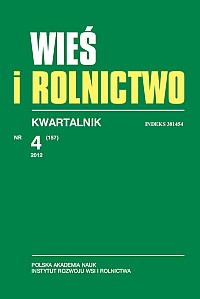„Czyńcie sobie ziemię poddaną” – czyli o różnych obliczach ponowoczesnego rolnictwa na przykładzie procesów zawłaszczania ziemi (land grabbing)
”Fill the earth and subdue it” – on various types of postmodern agriculture and land grabbing in the globalized world
Author(s): Katarzyna Jasikowska, Krzysztof GorlachSubject(s): Social Sciences
Published by: Instytut Rozwoju Wsi i Rolnictwa Polskiej Akademii Nauk
Keywords: land grabbing; post-modernization; hyper-rationalization; hyper-commodification; hyper-differentiation; hyper-individualization; globalization; postmodern agriculture; zawłaszczenie ziemi; postmodernizacja; hiperracjonalizacja; hiperutowarowienie
Summary/Abstract: The process of land grabbing has been analyzed in the presented article. The nature of this process consists in efforts to take possession of or to merely control particular areas of land that have been qualified as agricultural ones. Some leading actors of postmodern, global capitalism perceive land grabbing as an important mechanism for controlling the world economic system as well as a source of huge profits. The side effect of such process leads to various negative phenomena and social consequences, including marginalization and exclusion of many rural and agricultural communities. Moreover, it results in – what we call – the new rural poverty as well as new types of unsustainable social and economic (class) relations based on domination and exploitation. This particular process has been analyzed in the context of the so-called post-modernization theory that covers the following aspects: hyper-rationalization, hyper-commodification, hyper-differentiation and hyper-individualization. Concluding, contemporary postmodern agriculture seems to be not only a form of post-productionist activity or of sustainable development but also an effect of post-modernization processes leading to the dynamic development of capitalism with an “ugly face”, to unsustainable management of natural resources (including land as a fundamental type of such resources) and huge profits resulting from the growing asymmetry of knowledge, power and ownership. Celem artykułu jest próba prześledzenia pewnego procesu, który charakteryzuje współczesne rolnictwo, a który w literaturze przedmiotu określony bywa mianem „zawłaszczania ziemi”. Istotą jego jest przejmowanie na własność lub choćby tylko poddawanie kontroli określonych obszarów, które zakwalifikowane zostały jako tereny rolnicze. Wiodący aktorzy na globalnej scenie ponowoczesnego kapitalizmu dostrzegli w kontroli samych procesów produkcji rolnej ważny element kontroli światowego systemu ekonomicznego i ogromne źródło zysków. Jak staraliśmy się wykazać, uruchomiło to na skalę globalną rozmaite negatywne zjawiska i procesy społeczne, takie jak np. marginalizacja i wykluczenie całych społeczności wiejskich i rolniczych. Prowadzi to do zjawisk, które określić można mianem „nowego ubóstwa wiejskiego” i rodzi nową postać niezrównoważonych, opartych na wyzysku i dominacji relacji społecznych i ekonomicznych (klasowych). Proces ten próbujemy analizować w kontekście teorii postmodernizacji, wskazującej na cztery jego aspekty, jakimi są: hiperracjonalizacja, hiperutowarowienie, hiperzróżnicowanie oraz hiperindywidualizacja. Współczesne ponowoczesne rolnictwo to zatem nie tylko przejawy postproduktywistycznej aktywności czy rozwoju zrównoważonego, ale także efekt procesów postmodernizacji prowadzących do dynamicznego rozwoju kapitalizmu o „brzydkiej twarzy”, niezrównoważonej gospodarki zasobami naturalnymi (spośród których ziemia jest tym fundamentalnym zasobem) i gigantycznych zyskach.
Journal: Wieś i Rolnictwo
- Issue Year: 157/2012
- Issue No: 4
- Page Range: 9-35
- Page Count: 27
- Language: Polish

